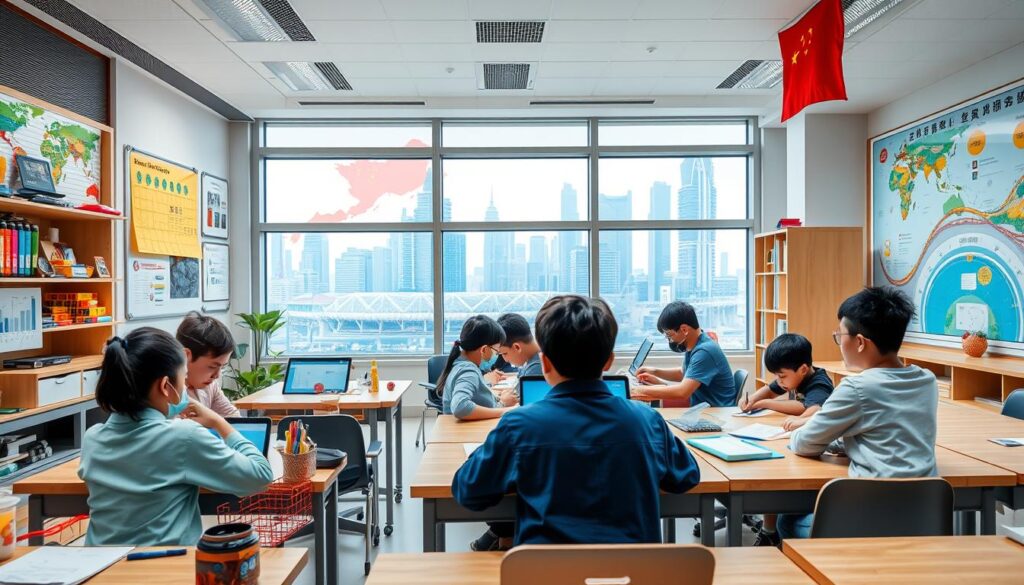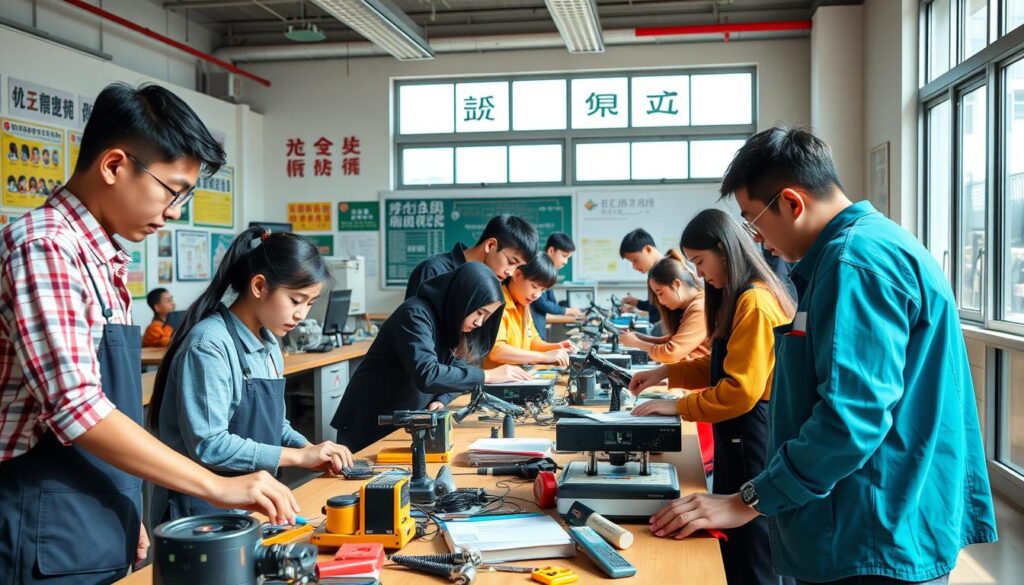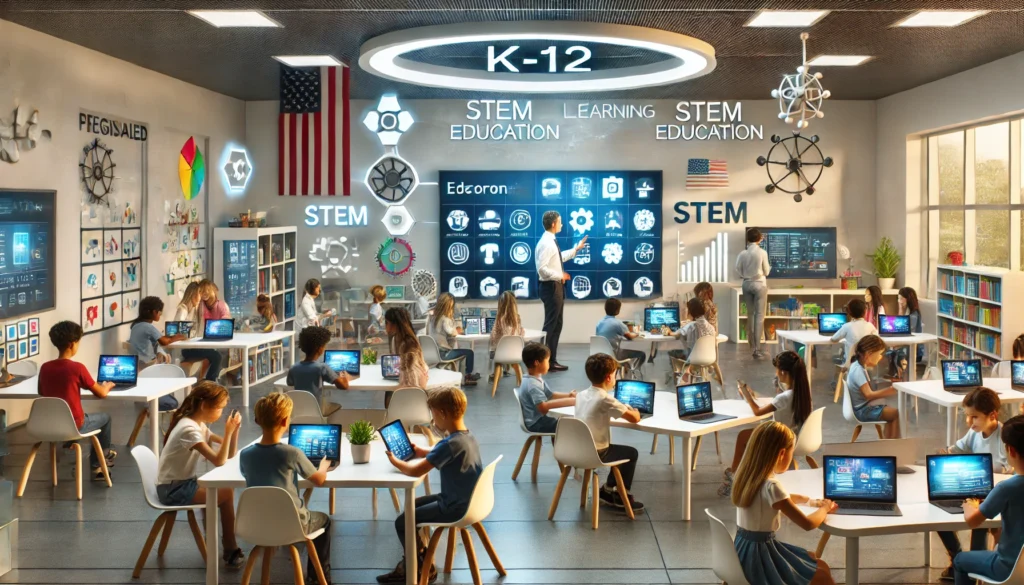China’s economy is growing fast, and it’s getting more important to have a skilled workforce. This is key for innovation and keeping up with growth. So, China is changing its education to focus more on technical skills. This aims to fill the skills gap and match education with the economy’s needs.

Key Takeaways
- China is overhauling its education system to develop a skilled workforce capable of meeting the country’s economic needs and driving innovation.
- The new education policies focus on strengthening vocational training and aligning curriculum with industry demands.
- Investments are being made to upgrade technical and vocational schools, promoting apprenticeships and public-private partnerships.
- Efforts are being made to address the rural-urban divide in access to quality education and technical training.
- Incentives and support are being provided to attract and retain skilled workers, improving their social status and salaries.
Why New Chinese Education Policies Focused on Developing Skilled Workers
China’s fast-growing economy is pushing for a workforce with top skills. The country’s new education plans aim to fill the skills gap. They want to make sure the education system matches the changing economic needs.
Vocational education is now key in China to build a skilled workforce. The government is focusing on practical skills to close the China skills gap. This ensures the workforce can handle the modern economy’s demands.
China’s education changes come from realizing old academic ways don’t cut it anymore. The importance of vocational education is clear. It gives students the skills and training needed for the job world.
| Skill Demand | Skill Supply |
|---|---|
| Increased demand for skilled technicians, engineers, and professionals in emerging industries such as renewable energy, advanced manufacturing, and technology | Shortage of workers with the necessary technical and vocational skills to meet the demands of these industries |
| Growing need for workers with specialized knowledge and practical abilities to drive innovation and productivity | Predominance of traditional academic programs that do not adequately prepare students for the realities of the job market |
China is working to make its education match its economic goals. This will help create a workforce ready for a sustainable, knowledge-based economy. It’s all about driving growth and development over time.

“The key to China’s future economic success lies in its ability to develop a highly skilled and adaptable workforce that can meet the demands of the 21st century labor market.”
The Importance of Vocational Education and Training
In China, the government sees vocational education and training as key. They help bridge the skills gap and match education with job market needs. This focus ensures graduates have the skills needed for different industries, boosting the economy and society.
Bridging the Skills Gap
China’s vocational programs aim to fix the mismatch between what graduates know and what employers want. They make sure courses and teaching fit industry needs. This way, students get practical skills, bridging the skills gap, and become more employable.
Aligning Education with Economic Needs
China is putting more effort into vocational education and training. This shows the government’s dedication to aligning education with economic needs. It makes sure the workforce can handle the changing demands of industries, making vocational education and training in China relevant to the job market and economy.
| Key Aspects of Vocational Education and Training in China | Benefits |
|---|---|
| Bridging the skills gap | Enhances employability and meets industry demands |
| Aligning education with economic needs | Supports the evolving demands of various industries |

“Vocational education and training plays a crucial role in enabling China to develop a skilled workforce that can drive economic growth and innovation.”
Revamping Curriculum and Teaching Methods
China is working hard to make its education better. It’s changing the curriculum and teaching methods to meet the needs of the job market. This change aims to prepare students for success in today’s economy.
More practical learning is being added to the curriculum. This means more project-based learning, solving problems, and real-world applications. Students will learn important skills like critical thinking, communication, and teamwork.
- Increased emphasis on practical, application-based learning
- Integration of problem-solving and project-based activities
- Developing critical thinking and soft skills alongside technical expertise
China is also trying new ways to teach that go beyond old lectures. They’re using technology, like online learning and virtual simulations, to make learning more interactive. These methods help students understand subjects better and get more involved in their education.
“The future of China’s economic development lies in the hands of our skilled workforce. By revamping our education system, we are investing in the next generation of innovators and problem-solvers who will drive our nation forward.”
The china education curriculum reform and new teaching methods in china are key to keeping up with the global economy. This big change will help Chinese students get the skills and mindset needed for the 21st century job market.
Investing in Technical and Vocational Schools
The Chinese government has put a lot of money into technical and vocational schools. These schools are key in making skilled workers for different industries. They aim to give students top-notch training that gets them ready for their careers.
Upgrading Facilities and Equipment
China is focusing on making technical and vocational schools better. The government has put a lot of money into improving the buildings and getting the newest equipment. This makes sure students learn in modern places and get real-world training, ready for the changing job market.
| Indicator | 2015 | 2020 |
|---|---|---|
| Number of Technical and Vocational Schools | 12,847 | 14,258 |
| Government Spending on Technical and Vocational Education (in billion CNY) | 234.6 | 389.2 |
| Percentage of Students Enrolled in Technical and Vocational Schools | 44.8% | 48.1% |
The table shows how much China has grown its technical and vocational education in five years. More schools, more money from the government, and more students show the government’s strong support for a skilled workforce. This helps China move forward economically.
“Upgrading the facilities and equipment in technical and vocational schools is crucial to ensure that our students receive the best possible training and are prepared to meet the evolving needs of the job market.”
– Education Minister, China
Promoting Apprenticeships and On-the-Job Training
In China, the government is working hard to close the gap between school and the job world. They’re pushing apprenticeships and on-the-job training. These programs give students real-world skills that employers want.
Apprenticeships let students learn from experts in their field. They mix classroom learning with real work. This way, they get a full view of the industry and the skills they need for a good career.
- Apprentices work with mentors who teach them the details of their job. This helps them get better at technical skills and solving problems.
- Companies get to keep skilled workers who fit their needs through apprenticeships.
- The government helps companies that offer apprenticeships with incentives and support.
China also values on-the-job training. It lets students use what they learned in real situations. This makes moving from school to work easier.
- Companies and schools work together to create training that meets the job needs.
- Students get to work on projects, do simulations, and take part in hands-on activities.
- This kind of training makes students more ready for their jobs and makes them more attractive to employers.
By focusing on apprenticeships and on-the-job training, China is tackling the skills gap. These efforts help students and boost the economy and competitiveness of the country.
Collaborating with Industries and Employers
China’s education system is working hard to bring schools and industries together. This partnership aims to make sure education meets the needs of the job market and the economy.
Fostering Public-Private Partnerships
A big part of this effort is creating public-private partnerships. Schools and businesses team up to design courses, offer practical training, and help students find jobs. These partnerships make sure students learn what employers want, making the talent pipeline stronger.
Here are some ways these partnerships show up:
- Co-developing vocational and technical training that meets industry standards
- Internships and apprenticeships for real-world experience
- Joint research projects that use the strengths of both academia and industry
- Help with job placement and career advice
China is closing the gap between education and the job market through these partnerships. This helps the workforce gain the skills needed for growth and innovation.
“By aligning our educational system more closely with the needs of industries, we can ensure our graduates have the skills and knowledge to hit the ground running and contribute immediately to the success of their employers.”
| Collaboration Initiatives | Key Benefits |
|---|---|
| Co-designed Curriculum | Ensures curriculum relevance and industry-readiness |
| Apprenticeships and Internships | Provides hands-on, practical training for students |
| Joint Research Projects | Fosters innovation through academic-industry collaboration |
| Placement Assistance | Facilitates seamless transition of graduates into the workforce |
Addressing the Rural-Urban Divide in Education
China’s education reforms focus on more than just vocational training and matching curricula with job needs. The government is working hard to close the rural-urban education gap in China. This means making sure students in both rural and city areas get top-notch education. This is key to making education fair across China and building a skilled workforce everywhere.
To help bridge this gap, the Chinese government has started several projects:
- Improving rural school buildings and giving them modern tools and resources, just like city schools.
- Offering rewards and support for teachers to work in rural areas. This makes sure students there have great teachers.
- Creating online learning programs and using technology to bring quality education to students in far-off places.
- Setting up vocational and technical training centers in rural areas. These centers give locals the skills they need for jobs and help their local economies.
These steps aim to make education fair for everyone. Students from all over should get the chance to learn the skills and knowledge needed for success in China’s changing economy.
| Indicator | Rural Areas | Urban Areas |
|---|---|---|
| High School Enrollment Rate | 85% | 95% |
| Percentage of Teachers with Bachelor’s Degree | 78% | 92% |
| Percentage of Students Enrolled in Vocational Schools | 35% | 45% |
By tackling the rural-urban education gap in China, the government wants a fair and open education system. This will help build a skilled workforce in every part of the country. It will also boost education equity in China and push the nation forward economically and socially.
Incentives and Support for Skilled Workers
China is working hard to keep skilled workers by offering great incentives and support. They focus on making the social status and salaries of these workers better. This is especially true for those in high-demand technical and vocational fields.
Improving Social Status and Salaries
The Chinese government knows how crucial skilled workers are for growth and progress. So, they’re taking steps to make these workers more respected and well-paid:
- Launching public awareness campaigns to highlight the value and contributions of skilled workers
- Offering generous salary increases and bonuses for workers in critical industries
- Providing career advancement opportunities, such as management training and leadership development programs
- Granting prestigious awards and recognition to top-performing skilled workers
These efforts aim to build a culture that values and rewards technical skills. By doing this, China wants to attract more people to these in-demand fields. They hope to create a highly skilled and motivated workforce to keep driving economic growth.
“We are committed to elevating the status and compensation of our skilled workers, as they are the backbone of our nation’s progress.”
– [Name], Minister of Education, China
Challenges and Obstacles in Implementation
China’s big plans to change its education system and build a skilled workforce are promising. But, there are big challenges and obstacles to overcome. The challenges in implementing education reforms in China and the obstacles in developing a skilled workforce are complex and need a strong plan to fix them.
One big problem is the resistance to change in the current education system. Many people still see vocational training as less important than academic paths. Changing this view and showing the value of vocational training is hard.
Money is another big issue. Making big changes, improving vocational schools, and training teachers costs a lot of money. Making sure all students, in cities and rural areas, have good education is also hard because of limited funds.
- Resistance to change in the education system
- Stigma surrounding vocational education
- Funding constraints and resource allocation challenges
- Ensuring equitable access to quality education
- Coordinating efforts across various stakeholders
Also, the reforms needed are huge, and working together with many groups is tough. Government agencies, schools, and businesses must all work together. Making sure education keeps up with the changing job market is a big challenge that needs ongoing effort and teamwork.
Even with big challenges, China is still working hard to overcome the obstacles in developing a skilled workforce. Fixing these issues is key to China’s future economic and social growth.
Impact on China’s Economic and Social Development
China’s new education policies aim to make a skilled workforce. This will greatly help the country’s economic and social development. By matching education with job market needs, China plans to increase innovation and productivity. This will make the country more competitive in the economy.
These reforms could also help with social mobility and lower income gaps. By focusing on vocational and technical education, China offers chances for people from lower backgrounds to move up. This includes apprenticeships and working with industries.
| Impact on China’s Economy | Impact on China’s Social Development |
|---|---|
| Increased innovation and productivity Enhanced economic competitiveness Alignment of skills with market demands | Promotion of social mobility Reduction in income disparities Improved access to quality education |
The effects of these education reforms on China’s economy and social development will be big. China is working to build a workforce that is skilled and can adapt. This will help with sustainable growth and more social equality.
“The skills-based education reforms in China have the potential to transform the country’s economic landscape and create more opportunities for social advancement.”
Conclusion
China is changing its education focus to build a skilled workforce. This shift is a big move towards a more strategic approach to learning. By focusing on vocational training and working with industries, China aims to meet its economic needs and boost growth and innovation.
This change could greatly improve China’s education system and its economy and society. It’s all about making sure the country has the right skills for the future.
China needs a highly skilled workforce to stay competitive in the global market. With technology advancing, the demand for specialized skills is rising. China is updating its education to fill this skills gap. It’s working on improving technical schools and building partnerships with employers.
The success of China’s education reforms will shape its future. By tackling issues like the rural-urban divide and offering rewards for skilled workers, China can lead in innovation and tech. The future looks promising for China’s skilled workforce, thanks to its dedication to education.
FAQ
Why did China’s new education policies focus on developing skilled workers?
China’s economy is growing fast and moving towards more technology and innovation. This means it needs a workforce with the right skills. The new education policies aim to fill this skills gap and match education with the economy’s needs.
What is the importance of vocational education and training in China’s new education policies?
Vocational education and training are key in China’s new plans. They help bridge the skills gap and make sure graduates have the skills employers want. The curriculum and teaching methods are being updated to meet industry needs.
How is China revamping its curriculum and teaching methods to support the development of a skilled workforce?
China is changing its education to focus on practical skills and critical thinking. This includes more hands-on learning and training in problem-solving and technical skills.
How is China investing in technical and vocational schools?
China is investing a lot in technical and vocational schools. These schools are crucial for training skilled workers. The government is improving facilities and equipment to give students top-notch training.
How is China promoting apprenticeships and on-the-job training?
China is boosting apprenticeships and on-the-job training to link education with the job market. These programs give students real work experience and the skills employers look for.
How is China collaborating with industries and employers?
China is building stronger ties between schools and industries. This includes public-private partnerships to design curricula, provide training, and place graduates in jobs.
How is China addressing the rural-urban divide in education?
China is working to make sure all students, in both rural and urban areas, have access to quality education. This helps with social and economic equality and supports a skilled workforce everywhere.
What incentives and support is China providing for skilled workers?
China is offering incentives and support for skilled workers. This includes better social status, higher pay, career development chances, and other benefits to encourage people to choose technical and vocational fields.
What are the challenges and obstacles in implementing China’s new education policies?
China’s new education plans are ambitious but face challenges. Issues like resistance to change, funding problems, and cultural shifts are hurdles to overcome.
What is the expected impact of China’s education reforms on the country’s economic and social development?
China’s education reforms could greatly benefit the economy and society. By matching education with job market needs, China hopes to increase innovation, productivity, and competitiveness. These changes could also help reduce social and economic gaps.

